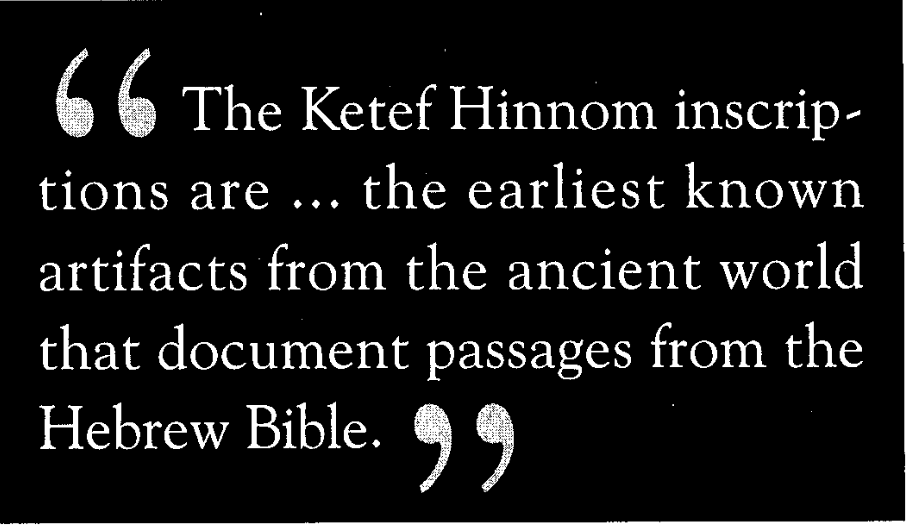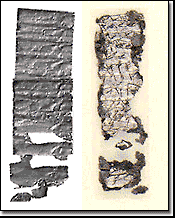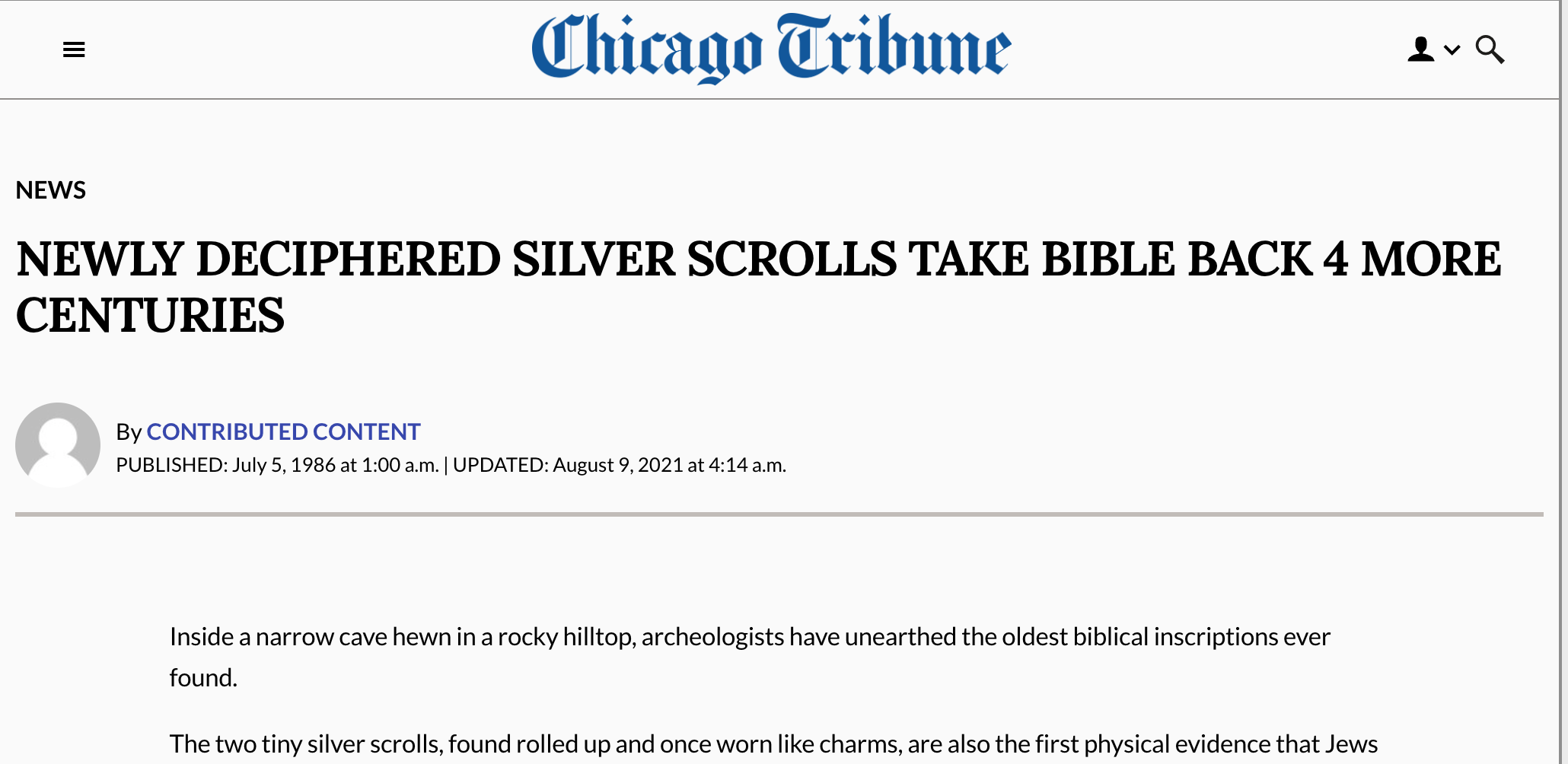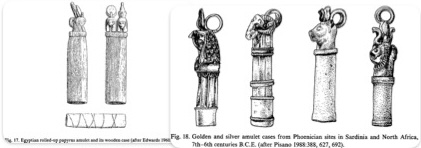


The headline looks decisive. But proceed with caution. I have not yet read in any scholarly publication that the silver scrolls, originally dated by their discoverer, Gabriel Barkay, circa 650 BCE, are evidence that any part of the Bible was known so early. What the inscriptions indicate is that a couple of passages in our Bibles drew on a source that went back so far. [See below for more information on the dates of the plaques.]
Nonetheless, a critic of the Hellenistic origin of the Hebrew Bible (a theme I have been dwelling on in recent posts) frequently threw up the challenge on another forum with this kind of rebuttal:
The late, great Ada Yardeni wrote … that the silver plaques do not prove the existence then of the Pentateuch. (Nor disprove of course.) Oddly, she wrote that “Only a discovery of biblical scrolls or even a fragment of a biblical scroll could serve as such a proof.” So writing on parchment or papyrus would count, but not writing on silver?
I did not think it worth investing much time to engage with that kind of protest. In short, I could have said:
- We have material evidence (the Dead Sea Scrolls) that books of the Bible existed in the third century.
- We have material evidence (the silver ‘plaques’) that a passage in the Bible was also known in the seventh century.
- The simplest explanation is that the third century source knew of a saying that existed as early as the seventh century.
- We might even think it perverse to claim that the earlier source was proof that some form of a later source must have existed before the earlier one!
No bigger than a cigarette filter tip
But let’s look at those “silver plaques”. They are interesting in their own right and for what they indicate about the background to the religion of the Bible. They were discovered in 1979 in Jerusalem. The image above shows them unrolled. That’s not how they were found, though:
At first viewing, they appeared to be tiny, somewhat corroded metallic cylinders, no bigger than the filter tip of a cigarette. On closer examination, it was realized that they were, in fact, tightly wound up “mini scrolls,” that, as later testing revealed, were made from almost pure silver. (Barkay 2003, 163)
Magic in the words
What makes them of special interest to historians is that they contain the same words we read in Numbers 6:24-26
24 Yahweh bless thee and keep thee;
25 Yahweh make His face shine upon thee, and be gracious unto thee;
26 Yahweh lift up His countenance upon thee, and give thee peace.
Before we look at how those words appear in the silver artefacts it is worth taking a closer look at the magic they contain even in the Hebrew Bible:
Among the verses from the Bible cited on some of those amulets and incantations the priestly blessing is represented many times. The priestly blessing is appropriate for use in magical contexts because of its inner structure. It is built up of three verses in a pyramid-like structure, the number of words increasing from 3 in the first verse to 5 in the second and to 7 in the third. The name YHWH is repeated three times. The number of the letters is 60 — all these numbers have a magical connotation. (Yardeni, 185)
Pre-biblical Yahwists
The first scroll (according to the 2004 Barkay reading, simplified) is inscribed with these words:
the Eternal … blessing more than any snare and more than Evil. For redemption is in him.
For YHWH is our restorer and rock. May YHWH bless you and may he keep you.
May YHWH make his face shine….
The second scroll consists of these words:
May [the name of the person wearing the scroll] be blessed by Yahweh, the warrior [or helper] and the rebuker of Evil:
May Yahweh bless you, keep you.
May Yahweh make his face shine upon you and grant you peace.
The principal difference between the biblical blessing and those in the silver scrolls is that the former is a collective blessing for the nation while the latter is a blessing for the individual.

Those silver scrolls were found in Jerusalem. There is another site on the Sinai border that was established about 100 years earlier with artwork and inscriptions expressing devotion to YHWH and his wife:
I have blessed you by YHWH of Teman and His asherah. May He bless you and may He keep you . . .
So calling on Yahweh to bless and keep his worshipers extends back long before there is any hint of the Biblical religion.
There’s more. The first scroll additionally has a passage echoed by Deuteronomy 7:9
| Deuteronomy 7:9 | First scroll |
| Know that Yahweh your God is God, the faithful God who keeps His gracious covenant loyalty for a thousand generations with those who love Him and keep His commands. | … who loves the covenant and mercy for those who love him and keep his commandments |
Protection against evil
What were those silver inscriptions? They were rolled up and most likely worn around a person’s neck. Throughout Phoenicia and North Africa archaeologists have unearthed amulet cases — some of wood, others of silver and gold — that held small inscribed scrolls that served to protect the wearer from evil.

The Ketef Hinnom inscriptions are therefore the earliest known artifacts from the ancient world that document passages from the Hebrew Bible. (Barkay 2003, 163)
Time to rethink
We think of Yahweh being merciful and keeping covenant with his people and blessing those who keep his commands as uniquely biblical. The covenant and commandments surely took on a different meaning with the later biblical narrative.
The finds described above give us quite a different perspective of the roots of the religion of YHWH.
–o0o–
Dating questions
The majority of scholars date the plaques to a time before the Babylonian exile but Nadav Na’aman disagrees. I quote his discussion because, despite being a minority voice, he offers a helpful overview of the question. (I have some difficulties with details of Na’aman’s perspective on this matter and tend to agree with the majority opinion, though that’s a separate discussion. There are no doubt more recent views that I have yet to read.)
On the basis of the palaeographic evidence, Barkay (1992: 169–174) originally dated the plaques to the second half of the seventh century BCE, whereas Yardeni (1991: 180) dated them to the early sixth century BCE. Most scholars who dealt with the plaques accepted either the mid-seventh-century or the late seventh–early sixth-century date (see literature in Berlejung 2008a: 211, nn. 41–42). Cross (2003: 23*, n. 23) dated the plaques to the late sixth century BCE, and Renz (1995a: 449–452) dated them to the Hellenistic period. The team dated the plaques to the seventh–sixth century BCE (Barkay et al. 2004: 52b). They examined Renz’s arguments in great detail and made it clear that only eight late Hellenistic vessels were unearthed in the repository, all located in its uppermost layer (Barkay et al. 2004: 43b). The team further demonstrated that no letter forms in these inscriptions point to a Hellenistic date (Barkay et al. 2004: 44–52), thus concluding that dating the plaques to this late period is highly unlikely.
. . .
In two recent articles, Berlejung (2008a: 211–212; 2008b: 45–47) suggested an early Persian date for the plaques, emphasising that amulets and stamps made of silver and gold are rare in Iron Age Palestine and that small objects of this kind appear only in the Persian period.7 Moreover, text amulets written on rolled papyrus, silver, or gold lamellae appear in large numbers in the Phoenician–Punic world in the sixth–fifth centuries BCE (Lemaire 2003 [link is to PDF]: 2007; Berlejung 2008b: 53–56, with earlier literature; 2010: 5–11; Smoak 2010: 427–429). The Persian period date of the manufacture of silver plaques strongly supports the date established by the orthographic analysis.
In sum, the archaeological and palaeographic data do not supply a firm date for the plaques; thus, the decision should be made on the basis of other considerations, in particular the orthographic data. In my opinion, the pre-exilic date for the plaques, originally suggested by Barkay and Yardeni and supported by the majority of scholars, cannot be maintained. Dating the plaques to the late sixth or early fifth century BCE is preferable, and is in keeping with all the available data. This dating corresponds with the conclusions I present in the final part of this article, which are drawn on entirely different grounds . . . .
- Na’aman, Nadav. “A New Appraisal of the Silver Amulets from Ketef Hinnom.” Israel Exploration Journal 61, no. 2 (2011): 184–95.
Barkay, Gabriel. “The Priestly Benediction on Silver Plaques from Ketef Hinnom in Jerusalem.” Tel Aviv 19, no. 2 (September 1992): 139–92. https://doi.org/10.1179/tav.1992.1992.2.139.
Barkay, Gabriel, Marilyn J. Lundberg, Andrew G. Vaughn, and Bruce Zuckerman. “The Amulets from Ketef Hinnom: A New Edition and Evaluation.” Bulletin of the American Schools of Oriental Research 334 (May 2004): 41–71.
Barkay, Gabriel, Marilyn J. Lundberg, Andrew G. Vaughn, Bruce Zuckerman, and Kenneth Zuckerman. “The Challenges of Ketef Hinnom.” Near Eastern Archaeology 66, no. 4 (December 2003): 162–71.
Chicago Tribune. “Newly Deciphered Silver Scrolls Take Bible Back 4 More Centuries” July 5, 1986. https://archive.md/fgrx4.
Gray, George Buchanan. A Critical and Exegetical Commentary on Numbers. New York, C. Scribner’s Sons, 1903.
Meshel, Zeev, Shmuel Aḥituv, and Liora Freud. Kuntillet ʻAjrud (Ḥorvat Teman): An Iron Age II Religious Site on the Judah-Sinai Border. Jerusalem: Israel Exploration Society, 2012.
Noth, Martin. Numbers: A Commentary. Philadelphia, Westminster Press, 1968.
Waaler, Erik. “A Revised Date for Pentateuchal Texts? Evidence from Ketef Hinnom.” Tyndale Bulletin 53, no. 1 (May 1, 2002).
Yardeni, Ada. “Remarks On the Priestly Blessing On Two Ancient Amulets From Jerusalem.” Vetus Testamentum 41, no. 2 (1991): 176–85.
Neil Godfrey
Latest posts by Neil Godfrey (see all)
- What Others have Written About Galatians (and Christian Origins) – Rudolf Steck - 2024-07-24 09:24:46 GMT+0000
- What Others have Written About Galatians – Alfred Loisy - 2024-07-17 22:13:19 GMT+0000
- What Others have Written About Galatians – Pierson and Naber - 2024-07-09 05:08:40 GMT+0000
If you enjoyed this post, please consider donating to Vridar. Thanks!

The Ketef Hinnom silver amulets with verbal parallels to Num 6:24-26 are extensively discussed, with bibliography, in Berossus and Genesis, 27-28. It is agreed by Gabriel Barkay (2004), who discovered the amulets (nice guy—met him in Jerusalem in 1997 when he led an archaeological tour of the City of David for a group of us Dead Sea Scrolls scholars), Ada Yardeni (1991), Levine (1993) and others that the amulets reflect an oral priestly formula and are of no evidentiary value in dating the Pentateuch/Numbers as a written text.
I don’t know which one of the four authors of Barkay, Lundberg, Vaugh and Zuckerman 2004 wrote the line quoted early in your article (“The Ketef Hinnom inscriptions are… the earliest known artifacts from the ancient world that document passages from the Hebrew Bible”), or the following in the Conclusions section of Barkay, Lundberg, Vaugh and Zuckerman 2004: “We can thus reassert the conclusion reached by most scholars that the inscriptions found on these plaques preserve the earliest known citations of biblical texts. The new readings outlined in this article show that these plaques not only contain biblical quotations, but they also provide us with the earliest examples of confessional statements concerning Yahweh.” Significantly, the article has multiple authors. Let us call them the B,L,V and Z sources, in our own modernized update of the Documentary Hypothesis. As a source critic I would point out that both quotes above have tendentious theological overtones consistent with the Fuller Theological Seminary (Lundberg), USC School of Religion (Zuckerman) or the [Lutheran] Gustav Adolphus College (Vaugn). So the article’s claims that the Ketef Hinnom amulets point to a pre-Hellenistic Torah derive from the L, Z or V sources.
They certainly do NOT derive from the B source, namely Gabriel Barkay, given that the very next paragraph essentially reverses the unwarranted conclusion from LZV, citing Barkay’s earlier publication notes: “As has already been noted (Barkay 1992: 176-81; Yardeni 1991: 181-85), the presence of the Priestly Blessing in this late preexilic context does not in and of itself prove that the biblical context in which the blessing appears in the MT had already been consolidated. However, this does point to the preexilic presence of formulations also found in the canonical text, particularly when the confessional statements concerning Yahweh in Ketef Hinnom I are taken into account.” This reiterates Barkay and Yardeni’s reasonable position in other articles, that the oral priestly formula is pre-exilic, but not necessarily part of the written biblical text known from later times.
Barkay is the only credible author of the four. He does not see the Ketef Hinnom amulets as pointing to an early Torah text. Quite the contrary, he properly and reasonably understands them as pointing only to a longstanding priestly oral formula.
Thank you for adding this comment! I should have remembered that you discussed the amulets in your Berossus book and am quite embarrassed that I did not incorporate your analysis into the post.
Always happy to pop in with a comment on your blog, which provides some of the highest quality and accessible analysis of biblical topics currently available in cyberspace.